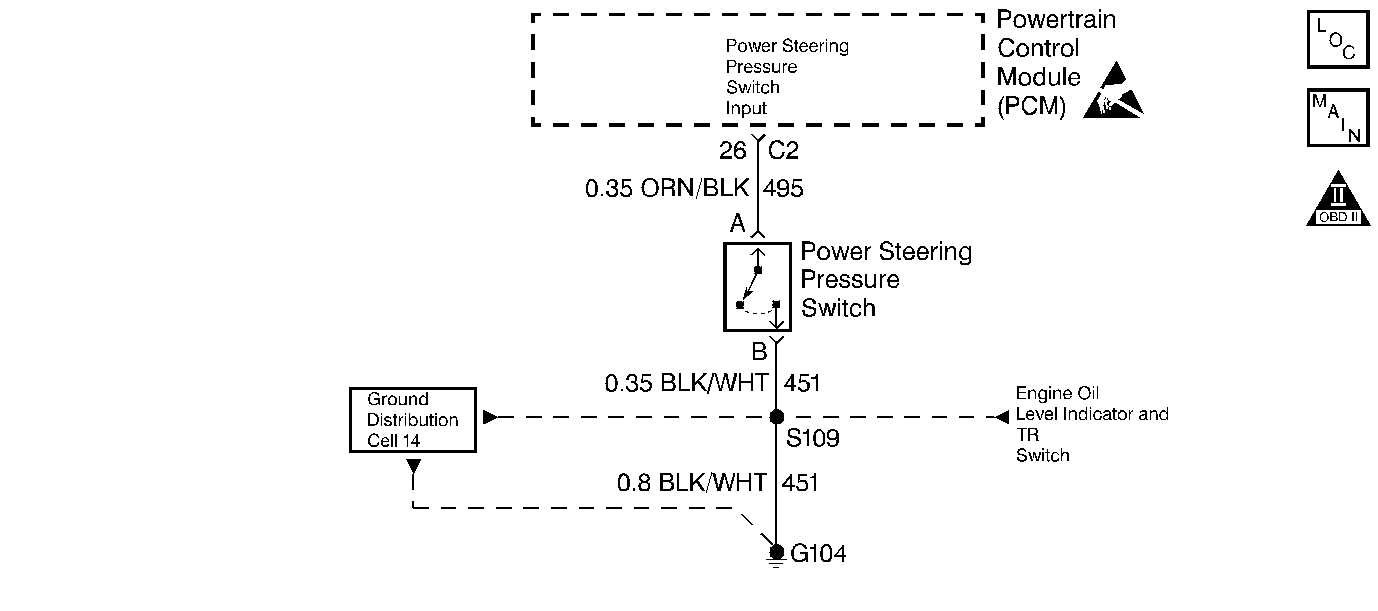
Circuit Description
The Power Steering Pressure (PSP) switch is a normally open pressure switch located in the high pressure (outlet) hose of the power steering system. The PCM applies a voltage (about 12.0 Volts) to the sensor. When power steering pressure is low the PSP switch is open and the PCM senses high signal voltage (low engine load). When power steering pressure is high, such as during parking maneuvers, etc., the PSP switch closes, and the PCM senses low signal voltage (high engine load). The PCM will increase the idle air rate and retard the timing to compensate for the additional load on the engine.
Diagnostic Aids
| • | A pressure switch that will not close or an open circuit may cause the engine RPM to drop when power steering loads is high. |
| • | A switch that will not open or the signal circuit shorted to ground may have an adverse effect on idle quality. |
Inspect all related wiring and connectors including the connections at the PCM. These may cause an intermittent malfunction. Check for damaged, corroded or pushed out terminals.
Step | Action | Value(s) | Yes | No |
|---|---|---|---|---|
1 | Was the Powertrain On-Board Diagnostic (OBD) System Check performed? | -- | ||
2 |
Does the scan tool indicate PSP switch Normal? | -- | ||
3 | Turn the steering wheel and hold momentarily against stop. Does the scan tool indicate PSP switch High Pressure? | -- | Go to Diagnostic Aids | |
4 |
Does the scan tool indicate PSP switch Normal? | -- | ||
5 |
Is the test light OFF? | -- | ||
6 |
Does the scan tool indicate PSP switch High Pressure? | -- | ||
7 | Using a fused jumper wire connected to ground, probe the signal circuit terminal in the PSP switch harness connector. Does the scan tool indicate PSP switch High Pressure? | -- | ||
8 |
Does the test light illuminate? | -- | ||
9 | Check for faulty connections at the PCM. Was condition found and corrected? | -- | ||
10 | Check for faulty connections at the PSP switch. Was condition found and corrected? | -- | ||
11 | Repair the open PSP signal circuit. Is the repair complete? | -- | -- | |
12 | Repair the PSP signal circuit for a short to ground. Is the repair complete? | -- | -- | |
13 | Repair open PSP ground circuit. Is the repair complete? | -- | -- | |
14 | Replace the PSP switch. Is the repair complete? | -- | -- | |
15 |
Important: The replacement PCM must be reprogrammed. Refer to Powertrain Control Module Replacement/Programming . Replace the PCM. Is the repair complete? | -- | -- | |
16 | Operate the vehicle within the conditions under which the original symptom was noted. Does the system now operate properly? | -- | System OK |
